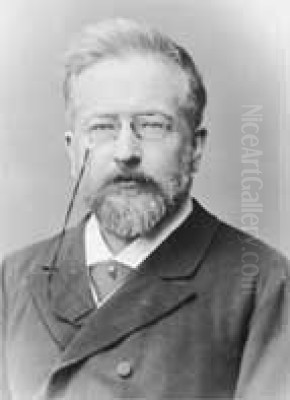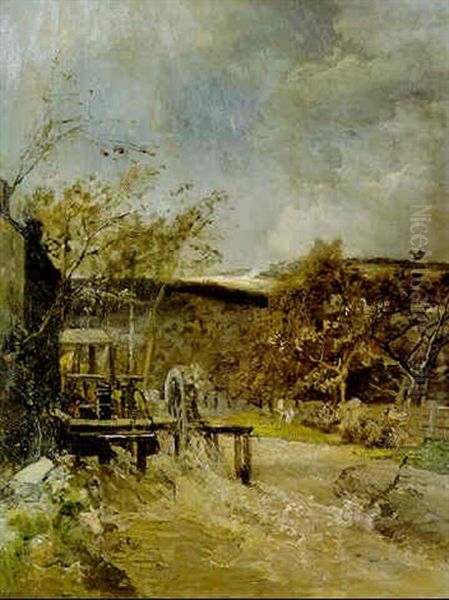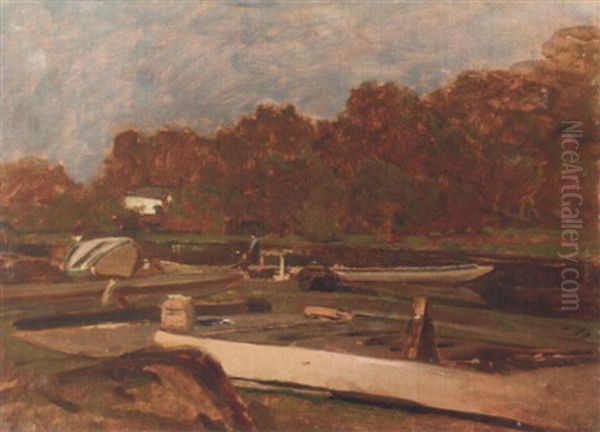
Emil Jakob Schindler stands as one of the most significant figures in 19th-century Austrian art, a landscape painter whose work masterfully captured the nuances of nature and atmosphere. Born in Vienna in 1842 and passing away prematurely in 1892, Schindler navigated the artistic currents of his time, developing a distinctive style often termed "Poetic Realism" or "Stimmungsimpressionismus" (Mood Impressionism). His legacy lies not only in his evocative canvases but also in his profound influence as a teacher and central figure in the Viennese art scene leading up to the turn of the century. He bridged the gap between the fading echoes of Romanticism and the burgeoning modern sensibilities that would define the Vienna Secession.
Early Life and Formative Years
Emil Jakob Schindler was born on April 27, 1842, in the Viennese suburb of Leopoldstadt. Contrary to the path often taken by artists of the era, he hailed from a relatively affluent background. His father, Jakob Schindler, was a successful industrialist involved in the cotton spinning and textile trade. The family initially envisioned a military career for young Emil, a common aspiration for sons of the established bourgeoisie at the time. However, Schindler's artistic inclinations proved stronger than familial expectations.
Forsaking a future in the military, Schindler enrolled at the prestigious Academy of Fine Arts Vienna (Akademie der bildenden Künste Wien) in 1860. There, he studied under the tutelage of Professor Albert Zimmermann, a German landscape painter known for his heroic and often dramatic depictions of nature. Zimmermann's studio was a significant training ground, but Schindler also absorbed influences from other sources. He diligently studied the works of 17th-century Dutch masters, particularly landscape specialists like Jacob van Ruisdael and Meindert Hobbema, whose meticulous attention to detail and atmospheric effects resonated with him. Another influential teacher at the Academy was Christian Griepenkerl, though Schindler's primary focus remained landscape under Zimmermann.

His early works reflect these academic foundations, showing a careful rendering of form and a leaning towards the established landscape traditions. However, even in these formative years, a unique sensitivity towards mood and light began to emerge, hinting at the more personal style he would later develop. Financial stability was not immediate; despite his family's background, Schindler faced periods of economic hardship, sharing lodgings at times with fellow artists like Julius Victor Berger.
The Emergence of Poetic Realism
Schindler's artistic journey led him away from the purely heroic or dramatic landscapes favored by some of his contemporaries. He became increasingly drawn to capturing the subtle, intimate, and often melancholic beauty of the natural world. His style evolved into what art historians call "Poetic Realism" or, more specifically within the Austrian context, "Stimmungsimpressionismus" (Mood Impressionism). This approach sought not just to accurately represent a scene (Realism) but also to infuse it with a palpable sense of atmosphere, emotion, and subjective feeling (Poetic/Mood).
A crucial influence on this development was the French Barbizon School. Schindler deeply admired the work of painters like Jean-Baptiste-Camille Corot, Théodore Rousseau, and Charles-François Daubigny. These artists had rejected academic constraints to paint directly from nature (en plein air), focusing on capturing the transient effects of light and weather, and imbuing their landscapes with a quiet lyricism. Schindler adopted similar practices, spending considerable time sketching and painting outdoors, particularly in the Austrian countryside.
Schindler's Poetic Realism is characterized by a delicate handling of light and shadow, a preference for soft, harmonious color palettes, and an emphasis on capturing specific times of day or weather conditions – misty mornings, tranquil evenings, the dampness after rain. His works often evoke a sense of stillness and contemplation, inviting the viewer to share in his emotional connection to the landscape. While related to French Impressionism in its focus on light and atmosphere, Schindler's style generally retained a greater degree of representational detail and a more subdued, introspective mood compared to the brighter, more fragmented brushwork of artists like Claude Monet or Pierre-Auguste Renoir.
Landscapes of Austria and Beyond

The Austrian landscape provided Schindler with his primary source of inspiration. He was particularly drawn to the regions around Vienna, the Danube River valley, and the picturesque Salzkammergut lake district. He depicted familiar scenes – forest interiors, riverbanks, marshlands, old farmhouses, and quiet village corners – with profound sensitivity. The Prater wetlands near Vienna, with their poplar trees and reflective waters, were a recurring motif in his work. He captured the changing seasons with remarkable fidelity, from the fresh greens of spring to the golden hues of autumn and the stark beauty of winter.
Schindler was not confined to Austria, however. His travels provided fresh perspectives and subjects. He journeyed to Venice, capturing the unique interplay of light, water, and architecture in the lagoon city. Trips to the Dalmatian coast, particularly Ragusa (modern-day Dubrovnik), resulted in powerful depictions of the Adriatic Sea, showcasing his ability to render the dynamic movement of water and the stark coastal light. He also visited Holland, likely reinforcing his connection to the Dutch landscape tradition that had influenced him early in his career.
Regardless of the location, Schindler's approach remained consistent: to find the poetic essence within the observed reality. He often focused on seemingly unremarkable scenes, elevating them through his masterful control of light and atmosphere. His paintings are rarely just topographical records; they are meditations on nature's quiet beauty and its power to evoke emotion. He also subtly critiqued the encroachment of industrialization on the natural world, championing the preservation of unspoiled landscapes through his art.
Masterworks and Signature Pieces
Several paintings stand out as representative of Schindler's mature style and artistic achievements.
Pax (1891): Housed in the Belvedere Museum in Vienna, this large-scale work is a quintessential example of Schindler's late Romantic, atmospheric landscape painting. Its title suggests a theme of peace and tranquility, likely embodied in a serene natural setting rendered with his characteristic sensitivity to light and mood. The scale indicates its importance as a major statement piece from late in his career.
Surf at Ragusa (also known as View of Ragusa or similar titles, c. 1887/88): This work, held by the Leopold Museum in Vienna, exemplifies his Dalmatian period. It captures the energy of the sea crashing against the rocky coast near Ragusa. The painting demonstrates his skill in depicting moving water and the specific quality of Mediterranean light. Works from this period are highly sought after, with one View of Ragusa achieving a significant price (over €317,500) at a Dorotheum auction, highlighting Schindler's market value.
Bauerngehöft im Frühling (Farmstead in Spring, 1882): This painting showcases Schindler's interest in rural life and his attention to detail. Likely depicting a farm scene in the Austrian countryside, it would feature the characteristic elements of his Poetic Realism – careful observation combined with an evocative atmosphere, possibly using his noted technique of oil on double canvas for textural effect.
Forest Lane near Schärfling: Often cited as a masterpiece of Austrian Mood Impressionism, this work likely depicts a path winding through a wooded area, possibly near Lake Attersee in the Salzkammergut. Such paintings are celebrated for their masterful rendering of light filtering through foliage, creating intricate patterns of light and shadow, and evoking the quiet solitude of the forest interior.
Beyond these specific examples, Schindler produced numerous views of Goisern, the Danube near Plankenberg, the Vienna Prater, and various forest scenes, all imbued with his signature atmospheric quality. His contributions also extended to illustration; he provided drawings for the monumental publication Die österreichisch-ungarische Monarchie in Wort und Bild (The Austro-Hungarian Monarchy in Word and Picture), further cementing his reputation.
Schindler and the Plankenberg Artists' Colony
In 1885, Schindler rented Plankenberg Castle near Neulengbach, west of Vienna. This move marked the beginning of an important phase in his life and career, establishing an informal artists' colony that became a significant center for landscape painting in Austria. Schindler, already a respected figure, acted as a mentor and guide to a circle of younger artists who gathered around him.
His teaching methods emphasized direct observation of nature, encouraging his students to work en plein air and develop their own sensitivity to light and atmosphere. He fostered a collaborative and supportive environment, although his own strong artistic personality undoubtedly set the tone. Among his most notable students and associates who frequented Plankenberg were:
Carl Moll: Perhaps Schindler's closest student, Moll began studying with him privately in 1881. He absorbed much of Schindler's approach to landscape but later developed his own distinct style, becoming a key figure in the founding of the Vienna Secession. His relationship with the Schindler family became deeply personal.
Marie Egner: A talented landscape and floral painter, Egner studied with Schindler and often spent summers painting alongside him and his family, particularly in the Salzkammergut.
Olga Wisinger-Florian: Another prominent female artist associated with Schindler, Wisinger-Florian initially focused on piano before turning to painting. She developed a vibrant, expressive style of landscape painting, influenced by Schindler's emphasis on mood but often employing bolder colors.
Tina Blau: While perhaps more of a contemporary and peer, Blau was another leading Austrian landscape painter associated with the Mood Impressionist movement, sometimes linked to Schindler's circle due to shared artistic concerns and exhibition activities.
Theodor von Hörmann: An important Austrian landscape painter whose work sometimes shows affinities with Schindler's atmospheric approach.
Rudolf Ribarz: Another landscape painter of the period who may have had connections to Schindler's circle.
The Plankenberg years were highly productive for Schindler and influential for his students. The collective focus on capturing the Austrian landscape's specific moods solidified the importance of Stimmungsimpressionismus as a distinct contribution to European art of the period.
A Complex Personal Life
While Schindler achieved considerable professional success, his personal life was marked by complexities and underlying tensions. In 1879, he married Anna Sofie Bergen (1857–1938), a singer who had studied voice but ultimately gave up her career prospects upon marriage. The couple had two daughters who survived infancy: Alma Margaretha Schindler (born 1879), who would later become the famous composer, writer, and socialite Alma Mahler-Werfel, and Margarethe (Grete) Julie Schindler (born 1881).
The marriage, however, was reportedly strained. Sources document that Anna Schindler engaged in extramarital affairs. One significant relationship was with the painter Julius Victor Berger, who had been a friend and flatmate of Schindler's in earlier, leaner years. More enduring and impactful was Anna's long-term relationship with Schindler's student and assistant, Carl Moll. This affair began during Schindler's lifetime and continued discreetly.
The household dynamic at Plankenberg Castle must have been intricate, with Moll living and working in close proximity to the family while maintaining this secret relationship with Anna. Despite these undercurrents, Schindler seems to have remained dedicated to his work and his role as a mentor. The extent to which he was aware of these relationships is debated by biographers, but the situation undoubtedly contributed to a complex family environment that profoundly shaped his daughter Alma's later life and memoirs. After Schindler's death, Anna and Carl Moll married in 1895, and Moll became a devoted stepfather to Alma and Grete.
Recognition, Later Career, and Untimely Death
Despite any personal turmoil, Schindler's artistic reputation grew steadily throughout the 1880s and early 1890s. He received numerous awards and honors, including the prestigious Reichel Prize in 1887, followed by medals in Munich and Berlin, confirming his standing not just in Austria but internationally. He became an honorary member of the Vienna Academy of Fine Arts and the Munich Academy. His works were regularly exhibited at the Vienna Künstlerhaus and other major venues.
He continued to paint prolifically, refining his atmospheric style and exploring new motifs. His work retained its focus on the intimate beauty of nature, often imbued with a sense of gentle melancholy or profound peace. He remained committed to his plein air practice, seeking authenticity in his depictions of the Austrian landscape he loved.
Tragically, Schindler's flourishing career was cut short. While traveling, he succumbed to the effects of chronic appendicitis, a condition that was difficult to treat effectively at the time. He died on August 9, 1892, in Westerland on the island of Sylt, Germany, at the age of just 50. He was at the peak of his artistic powers, leaving behind a significant body of work and a lasting influence on Austrian art. In recognition of his contributions, he was granted an honorary grave (Ehrengrab) in Vienna's Central Cemetery (Zentralfriedhof), and a monument was later erected in his honor in the Vienna Stadtpark.
Legacy and Enduring Influence
Emil Jakob Schindler is regarded as one of the most important Austrian painters of the later 19th century. His primary contribution lies in his development and mastery of Stimmungsimpressionismus, or Poetic Realism. He successfully synthesized the detailed observation of Realism with a profound sensitivity to mood and atmosphere, capturing the unique character of the Austrian landscape with unparalleled lyricism.
His influence extended significantly through his teaching. By mentoring artists like Carl Moll, Marie Egner, and Olga Wisinger-Florian, he helped shape the next generation of Austrian landscape painters. Moll, in particular, played a crucial role in bridging Schindler's legacy with the emerging modernist movement. As a co-founder of the Vienna Secession in 1897, Moll helped usher in a new era of Austrian art, championed by figures like Gustav Klimt and later Egon Schiele. While Schindler's style differed greatly from the Secessionists, the emphasis on artistic individuality and atmospheric expression that he fostered provided fertile ground for these later developments.
Today, Schindler's works are held in major Austrian collections, including the Belvedere Museum, the Leopold Museum, and the Wien Museum, as well as in numerous private collections. His paintings continue to be admired for their technical skill, their evocative beauty, and their profound connection to the natural world. The enduring appeal of his work, reflected in strong auction results, confirms his status as a master of Austrian landscape painting whose poetic vision remains relevant and moving.
Conclusion
Emil Jakob Schindler carved a unique path in 19th-century Austrian art. Emerging from academic training, he embraced the influence of Dutch masters and French Barbizon painters to forge a deeply personal style of Poetic Realism. His evocative landscapes, particularly those capturing the moods of the Austrian countryside, established him as a leading figure of Stimmungsimpressionismus. Beyond his own artistic output, his role as a mentor at the Plankenberg colony nurtured a generation of painters and left an indelible mark on the Viennese art scene. Despite a complex personal life and an untimely death, Schindler's legacy endures through his masterful canvases, which continue to resonate with their quiet beauty and profound emotional depth, securing his place as a pivotal figure in the rich tapestry of Austrian art history.